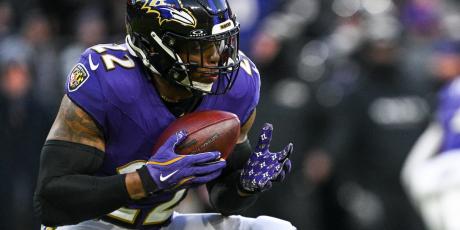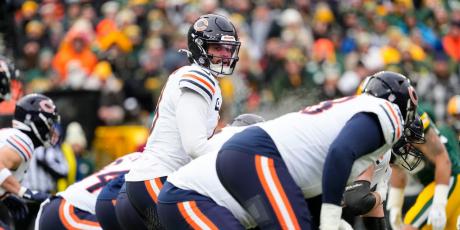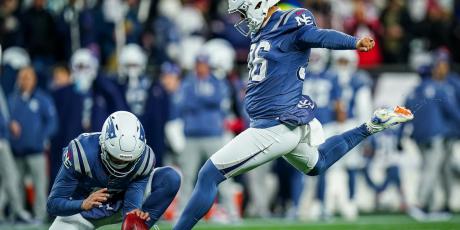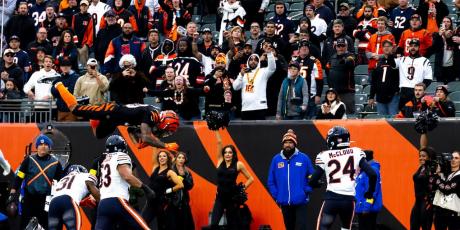How Play-Calling Tendencies Affect Fantasy Football (2020)

I've spent many offseasons here at 4for4 examining play-callers on new teams and how they impact fantasy football. Through that process, there has been one major recurring theme—the best players command the most touches and most coaches are at least somewhat fluid in their tendencies, especially when it comes to player usage. Like anything, there will be outliers—Greg Roman is going to run and Sean Payton is going to throw. Most coaches fall somewhere in the middle.
Create or join a 2020 Yahoo Fantasy Football League for free today
Rather than focusing on player-specific trends, this study will offer a historical, zoomed-out view of all the current play-callers in the league, dating back to the 2006 season. This will allow us to compare tendencies side by side while focusing on the parts of the game where these decision-makers have the greatest impact.
Throughout this analysis, I will note relevant trends of play-callers on new teams as well as which coaches stand out overall in each category. For certain stats, I focused on where a coach ranked in the category rather than the actual rate or raw number. The reason for this is to keep everything in context. Andy Reid, for example, threw 59.1% of the time in neutral game script in 2006, the third-highest rate in the league at the time—in 2019, that rate would have ranked 20th.
Also, note that I did my best to select only those seasons where a coach was actually the play-caller. Jason Garrett, for instance, delegated play-calling duties in multiple seasons as the head coach of the Cowboys.
After covering each topic for coaches who have play-calling experience at the NFL level, I will highlight any major takeaways for play-callers who will be on the headset for the first time in their career.
Before we get into it, let’s take a look at the current play-callers across the league. Coaches marked with an asterisk are new to their team but have play-calling experience at the NFL level. Coaches with two asterisks will be calling plays for the first time in the pros.
| Team | Play-Caller | Role |
|---|---|---|
| Arizona Cardinals | Kliff Kingsbury | Head Coach |
| Atlanta Falcons | Dirk Koetter | Offensive Coordinator |
| Baltimore Ravens | Greg Roman | Offensive Coordinator |
| Buffalo Bills | Brian Daboll | Offensive Coordinator |
| Carolina Panthers | Joe Brady** | Offensive Coordinator |
| Chicago Bears | Matt Nagy | Head Coach |
| Cincinnati Bengals | Zac Taylor | Head Coach |
| Cleveland Browns | Kevin Stefanski* | Head Coach |
| Dallas Cowboys | Kellen Moore | Offensive Coordinator |
| Denver Broncos | Pat Shurmur* | Offensive Coordinator |
| Detroit Lions | Darrell Bevell | Offensive Coordinator |
| Green Bay Packers | Matt LaFleur | Head Coach |
| Houston Texans | Tim Kelly** | Offensive Coordinator |
| Indianapolis Colts | Frank Reich | Head Coach |
| Jacksonville Jaguars | Jay Gruden* | Offensive Coordinator |
| Kansas City Chiefs | Andy Reid | Head Coach |
| Las Vegas Raiders | Jon Gruden | Head Coach |
| Los Angeles Chargers | Shane Steichen** | Offensive Coordinator |
| Los Angeles Rams | Sean McVay | Head Coach |
| Miami Dolphins | Chan Gailey* | Offensive Coordinator |
| Minnesota Vikings | Gary Kubiak* | Offensive Coordinator |
| New England Patriots | Josh McDaniels | Offensive Coordinator |
| New Orleans Saints | Sean Payton | Head Coach |
| New York Giants | Jason Garrett* | Offensive Coordinator |
| New York Jets | Adam Gase | Head Coach |
| Philadelphia Eagles | Doug Pederson | Head Coach |
| Pittsburgh Steelers | Randy Fichtner | Offensive Coordinator |
| San Francisco 49ers | Kyle Shanahan | Head Coach |
| Seattle Seahawks | Brian Schottenheimer | Offensive Coordinator |
| Tampa Bay Buccaneers | Byron Leftwich | Offensive Coordinator |
| Tennessee Titans | Arthur Smith | Offensive Coordinator |
| Washington Football Team | Scott Turner** | Offensive Coordinator |
Passing Rates in Neutral Game Script
One of the first questions asked about play-callers in the NFL is whether they favor the pass or the run. While this question is often well-intentioned, the answer can be deceptive if game script isn’t taken into account. Consider the 2019 Chiefs—Kansas City threw 62.5% of the time last year, the 11th-highest rate in the NFL. If we consider neutral game script (when the game is within 7 points), the Chiefs' 66.4% pass rate was the highest rate in the league.
By looking at neutral play splits, we can get an idea of how a play-caller truly wants to run their offense.
Playcaller's Passing Rates in Neutral Game Script (Ranking), 2006–2019
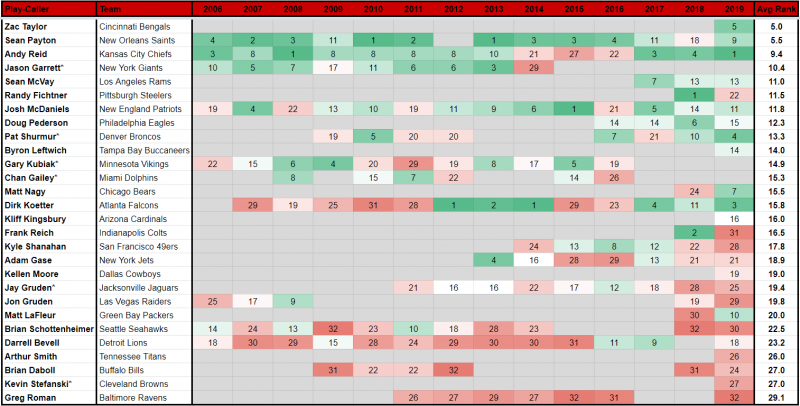
Takeaways
- The Bengals ranked sixth in total pass attempts last season (615). Surface analysis might attribute that to negative game script—they won just two games and ran the third-most plays while trailing by over a touchdown. Even in neutral game script, though, Zac Taylor’s 63.8% passing rate was the fifth-highest in the league. We don’t necessarily chase volume in fantasy when it comes to quarterback play but those targeting Joe Burrow as a late-round fantasy option have some reassurance that the rookie will have ample opportunity to throw in Cincinnati, regardless of game flow.
- Except for a short stretch from 2014–2016, Andy Reid has consistently called passes at one of the highest rates in the league, even before being tied to the best passer in the game. Given the weapons in Kansas City, it’s no surprise to see Reid near the top of the list in recent years.
- With an aging Drew Brees, it appeared that Sean Payton was tightening the reigns on the passing game in 2017 and 2018 but New Orleans jumped back into the top 10 in neutral passing rate last season, even with Brees missing significant time. One of the biggest reasons for this is how involved the Saints backs are in the passing attack—27.4% of New Orleans’ targets went to running backs in 2019, the fourth-highest rate in football. With the same backfield weapons and a reliable number two wide receiver in Emmanuel Sanders, expect Payton to let Brees air it out again in 2020.
- In this space last season, I suggested giving Matt LaFleur a mulligan for his time in Tennessee. Despite the notion that the Packers want to #EstablishIt, they still threw at the 10th-highest rate in neutral game script last season.
- Take Randy Fichtner’s and Frank Reich’s numbers with a grain of salt. With Ben Roethlisberger healthy and Philip Rivers now in Indianapolis, these teams’ passing numbers should be closer to 2018 than 2019.
- There’s Dirk Koetter and then there’s Dirk Koetter with Matt Ryan. When the two have been together, their teams have ranked outside of the top three in neutral passing rate just once, with an average rank of 3.6, which would be the highest among all current play-callers.
- The Air Raid offense that Kliff Kingsbury brought to the desert didn’t turn into the passing barrage that many were hoping for. While Arizona spread it out more than any team, their offense was arguably more beneficial for running backs than for pass-catchers. Kingsbury could give Kyler Murray more slack in 2020, especially with the addition of DeAndre Hopkins, but don’t expect the Cardinals to suddenly turn into the Chiefs.
- Those that were enamored by Mathew Stafford’s insane efficiency in 2019 might be glossing over the fact that last year marked the lowest rank in neutral passing rate for the Lions since Stafford’s rookie season. There is one aspect to Stafford’s passing game that Darrell Bevell may have awoken, however (more on that shortly).
- Greg Roman is the poster boy for quarterback efficiency over volume in fantasy. Each of his last five offenses has produced a QB15 or better finish with three top-12 seasons and Lamar’s QB1 year in 2019—having mobile passers doesn’t hurt, either. We may be seeing a similar trajectory with Brian Daboll.
New Playcallers
- It’s important that anyone projecting the Giants’ offense for 2020 understand the context of Jason Garrett’s time in Dallas. Over the past five seasons, the Cowboys have averaged the 10th-lowest passing rate in neutral game script but Garrett deferred play-calling duties to Scott Linehan and Kellen Moore over that stretch. When Garrett called plays, Dallas was quite pass-heavy.
- There are a few new play-callers this season with radically different philosophies than the 2019 iterations of the offenses that they are taking over. The most notable is Kevin Stefanski, whose Vikings ranked 27th in neutral passing rate last season—Stefanski’s new team, the Browns, ranked 12th. As for Minnesota, they could see an uptick in passing with Gary Kubiak calling plays.
- Chan Gailey hasn’t been in the league since 2016, but his last six offenses threw considerably less than the Dolphins team that he is taking over, which ranked sixth in neutral passing rate in 2019.
Deep-Ball Rates
Like touch or target volume, how often a team throws deep (15+ yards downfield) is often dependent on the roster—remember that air yards are a receiver stat— but some coaches have a clear affinity for the deep ball. This is especially important for fantasy purposes—while deep passes have proven to be the most efficient types of passes for fantasy, they also lead to more scoring volatility. Maybe more so than any of the trends in this article, this is where it’s most important to consider the coaches on the extreme ends of the spectrum.
Playcaller's Deep-Ball Rates, 2006–2019
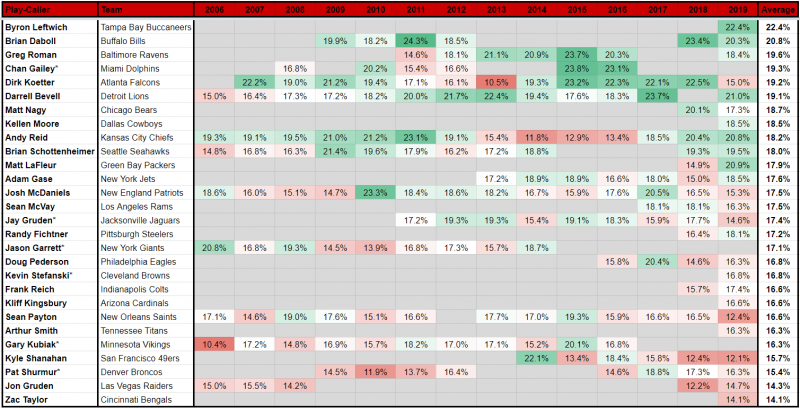
Takeaways
- Fantasy owners might blindly avoid passing offenses with coaches who trend towards the run but that may be a little shortsighted. Greg Roman and Brian Daboll consistently run at some of the highest rates in the league while also dialing up the deep ball more often than most coaches. As noted earlier, Roman has produced many starting-level fantasy quarterbacks and Daboll has done the same in recent years with Josh Allen. While Allen hasn’t converted his deep passes into big numbers yet, Buffalo did give him arguably the best deep target in the league in Stefon Diggs.
- Matthew Stafford has thrived off of volume for most of his career but he relied on efficiency in 2019. One big change was Darrell Bevell’s love of the deep ball. In the four seasons before Bevell’s arrival, Stafford averaged a 15% deep-ball rate, a number that would have ranked 29th among passers last year—that rate skyrocketed to 26.1% for Stafford lat season, the highest mark in the league. Detroit has the pass-catchers to continue a dangerous vertical attack even if they are a run-first team.
- Byron Leftwich served as an extension of Bruce Arians, who was atop this list last season. With Tom Brady now under center, this offense should be much more Brady than Arians/Leftwich.
- There’s a bit of a chicken or egg scenario when it comes to Derek Carr’s lack of deep passing, since he hasn’t had much of a downfield threat to throw to for most of his career. What isn’t accounted for in that is the fact that Jon Gruden has traditionally called deep pass plays at one of the lowest rates of any coach. In addition to a shortened offseason, rookie Henry Ruggs will need both his coach and quarterback to change their tendencies if Ruggs is going to maximize his talents early on.
New Play-Callers
- The Browns passing offense fell well short of expectations in 2019 and Kevin Stefanski’s run-first scheme is cause for concern in 2020. An added worry is how little Stefanski dialed up shot plays for the Vikings. Minnesota ranked 18th in deep-ball rate last season while Cleveland was seventh.
- On the flip side, Chan Gailey has been willing to throw deep as much as any play-caller in the league—his 19.3% average over his last six seasons would have ranked in the top-10 last year. He is taking over for a Miami offense that tied Minnesota in the bottom half of the league. With Fitz Magic throwing—at least to start the year—and two wide receivers that posted a deep-target rate above 30% last season, this offense could have some surprise boom weeks.
- Jay Gruden doesn’t stand out as a play-caller that is going to chuck it downfield all game but he is taking over a Jaguars offense that threw deep at the eighth-lowest rate last year. While it’s a limited sample, Gardner Minshew is in elite company when it comes to his efficiency on downfield throws.
Pace
Offensive pace may be one of the most underrated aspects in projecting football outcomes, especially when it comes to play-callers. What we are interested in is situation-neutral pace, as defined by Football Outsiders. According to FO, “The intent is to describe pace as dictated by each team's game plan or style of play, not pace that is situation-induced.” Like any data point, pace is just one piece to the puzzle but a dominant offense rarely has a slow neutral pace.
Over the last five seasons, teams that finished in the top five in scoring had an average rank of 12th in neutral pace—only four top-five scoring offenses finished in the bottom 10 in pace. Beyond projecting offenses for an entire season, there are game-level implications with pace stats. There have been 25 matchups in the last five years between teams that finished the season ranked in the top five in neutral pace and 16 of those games (64%) hit the over.
Similar to what we saw with neutral passing rates, where play-callers rank in situation-neutral pace can indicate their intentions for how they will run their offenses.
Playcaller's Situation-Neutral Pace (Ranking), 2006–2019
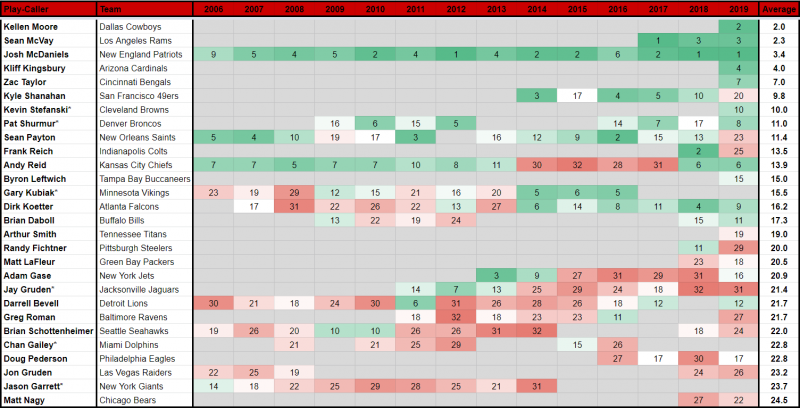
Takeaways
- Josh McDaniels stands out as the only coach that has kept his foot on the pedal over a large sample. The trust that the Patriots had in Tom Brady allowed the offense to run fast and smooth but even when Brady was out in 2008, New England still ranked in the top five in neutral pace. Cam Newton, however, has never led an offense that ranked higher than 12th, and his teams in Carolina had an average finish of 21st. The Panthers leaped to the top five in pace in 2019 without Cam.
- Along with McDaniels, Sean McVay, Byron Leftwich and Andy Reid are the only play-callers whose average finishes in neutral pace, deep-ball rate, and neutral passing rate all rank in the top 14. Jon Gruden is the only play-caller in this sample that ranks outside the top 20 in all three categories.
- There seems to be a trend of new play-callers running more uptempo offenses with Kellen Moore, Kliff Kingsbury, Zac Taylor and Kevin Stefanski all finishing in the top 10 in pace last season. This may be a trend to take note of when trying to project play-callers with no experience.
New Play-Callers
- Given Jason Garrett’s large sample size, his move to the Giants has the potential for the most extreme change in pace that we see in 2020. While Garrett’s offenses have averaged the ninth-slowest neutral pace, New York ranked eighth last season.
- On the other end of the spectrum—though just a one-year sample—is Stefanski. His Vikings were top-10 in pace last season but Cleveland ran the fifth-slowest offense in neutral situations.
- Although Chan Gailey looks like a fantasy-friendly coach in the aforementioned passing metrics, he loses ground with the pace of his offenses. Optimism surrounding the Dolphins might be tempered when we realize that Gailey’s numbers in this study most closely resemble those of Matt Nagy. A more optimistic—although not quite as similar—comp is Doug Pederson.
- The orchestrator of the fast-paced Giants offense last season, Pat Shurmur, will inherit a Broncos offense that ranked outside the top-20 in neutral pace in 2019. As a coach that likes to run an accelerated offense that leans on the pass but doesn’t throw deep often, Shurmur's closest comp is Sean Payton. This isn’t to say that Denver’s Drew will suddenly turn into Brees but the Broncos do have the weapons for Shurmur to oversee an efficient passing attack.
Rookie NFL Playcallers
There are four teams that will have new offensive play-callers with no experience at the NFL level but there can still be some insight to be had by looking at their previous jobs. Of course, coaches don’t always follow suit. Often, simply looking at a team’s trends from the previous season is the best predictor of tendencies for these new coaches. The following will take a brief look at each situation.
Joe Brady, Panthers (Offensive Coordinator)
Joe Brady was a disciple under Sean Payton for two years before serving as the passing game coordinator for the National Champion LSU Tigers in 2019. That offense produced Heisman Winner and No. 1 overall pick Joe Burrow, who led the nation in passing yards and touchdowns. The Tigers also produced two receivers—Ja'Marr Chase and Justin Jefferson—that finished in the top three in receiving yards in the country, as well as one of the best pass-catching backs in college. Clyde Edwards-Helaire was the only running back chosen in the first round of the 2020 NFL Draft.
It isn't hard to draw parallels between Brady's offense in Baton Rouge and the unit he inherits in Carolina. Obviously, there will be some limitations with Teddy Bridgewater under center, but the Panthers have the most versatile running back in the league, two receivers who can stretch the field and a top-10 talent in D.J. Moore. If we exclude 2019, Carolina ranked in the top half of the league in neutral passing rate just twice in the Cam Newton era—they jumped to eighth last season. With Brady in town, Teddy Two-Gloves could lead a sneaky-good passing attack.
Scott Turner, Football Team (Offensive Coordinator)
The Panthers started cleaning house after 12 games last year, replacing Ron Rivera and Norv Turner with Perry Fewell and Scott Turner for the final quarter of the season. With Scott taking over play-calling for Norv, Carolina's neutral passing rate jumped from 62.1% to 64.7%—the latter would have ranked third in the league over the entire season.
Rivera was hired as the head coach in Washington and brought Scott Turner along. For Turner to bring the pass-heavy philosophy he used late last year to the nation's capital, there will have to be major changes. Dan Snyder's team ranked 25th in neutral passing rate in 2019 and only four teams threw deep at a lower rate—the Panthers finished in the top half of the league in deep-ball rate. After Terry McLaurin, there aren't many exciting options for Dwayne Haskins to throw to, especially after Kelvin Harmon tore his ACL. Steven Sims did flash late last season and Antonio Gibson is a versatile running back that Rivera has already compared to CMC.
All of this may be a moot point if the football team from Dave Chapelle's hometown is as bad as expected—only one team has a lower win total according to DraftKings Sportsbook. Game script could force the team in FedEx Field to be one of the more pass-heavy units in football.
Shane Steichen, Chargers (Offensive Coordinator)
Shane Steichen has spent his last nine years coaching for the Chargers, save a one-year stint in Cleveland, but this offense will surely look different than the unit led by Ken Whisenhunt last year. Even more notable than the change at OC is the one at quarterback. At least to start the season, Tyrod Taylor will be under center, a stark contrast from the statue that is Philip Rivers. Los Angeles ranked 13th in neutral passing rate last season and last in neutral pace. Taylor's last three offenses in Buffalo all ranked in the bottom two in neutral passing rate with ranks of 14, 23, and 11 in pace. His mobility is a major factor in those passing numbers and will impact how Steichen manages this offense.
Tim Kelly, Texans (Offensive Coordinator)
This may be the least impactful of the coaching changes in 2020 as Tim Kelly as been in Houston since 2014 and will still work alongside Bill O'Brien, who called plays throughout Kelly's tenure. Here is how the Texans have ranked under O'Brien in the categories discussed in this article:
| Year | Neutral Pass % | Deep Ball % | Neutral Pace |
|---|---|---|---|
| 2019 | 23 | 15 | 14 |
| 2018 | 25 | 25 | 9 |
| 2017 | 20 | 3 | 8 |
| 2016 | 30 | 23 | 16 |
| 2015 | 21 | 16 | 3 |
| 2014 | 31 | 9 | 8 |
| Average | 25 | 15 | 10 |

